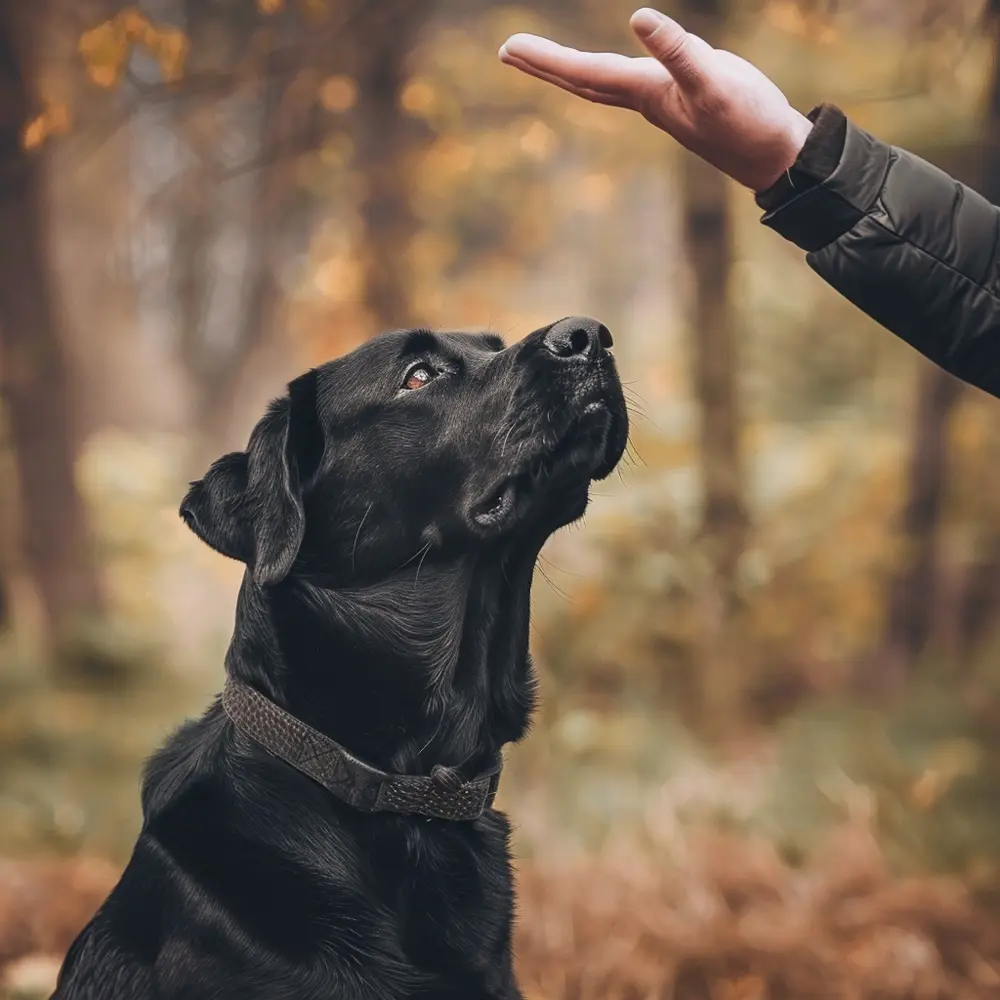Table of Contents:
Understanding the Basics of Training Hand Signals
Communication with our canine companions is critical for a harmonious relationship and effective training. One of the means to achieve this is through dog training using hand signals. These visual cues offer a clear and consistent way to convey your expectations to your dog. Before diving into specific gestures, it's vital to grasp the essence of hand signals and their place in dog training.
Hand signals are based on the principle that dogs are keen observers of body language and movement. They can often understand a physical cue more quickly than a verbal signal. By harnessing this natural canine ability, you can introduce a layer of comprehension that transcends the spoken language barrier. This is especially beneficial in noisy environments, or if your dog experiences hearing loss as it ages.
To start off, choose signals that are distinct and easy for your dog to differentiate. Consistency is key; the same hand movement should always mean the same signal. Begin with basic signals like sit, stay, and come, before introducing more complex instructions. Training should occur in a quiet and distraction-free setting, gradually moving to places with more distractions as your dog becomes more proficient.
Remember, patience and positive reinforcement are the cornerstones of teaching hand signals. Just like with verbal signals, your dog will learn best when rewarded for correct actions. With time and practice, hand signals can greatly enhance your communication and strengthen the bond between you and your pet.
The Benefits of Using Hand Signals in Dog Training
Introducing hand signals in dog training comes with a host of advantages that enhance the overall training experience. Among the gains are improved focus and attention from your dog. With the use of gestures, your dog may become more attentive, gazing at you for cues, and therefore becoming more in sync with your instructions.
Another benefit lies in the versatility of hand signals, allowing for effective communication in various circumstances. Whether in a park bustling with activity, or in situations where verbal signals might be drowned out, visual hand signals rise to the challenge, ensuring commands are always received and understood.
Hand signals also foster a sense of silent dialogue between you and your dog, creating a private language that transcends verbalization. This can foster deeper connections as you and your dog communicate subtly yet effectively. Professional dog trainers often employ hand signals for this very reason, to mould a communicative bond that is both efficient and discreet.
Lastly, the long-term benefits of conditioning dogs with hand signals include their use with ageing pets who may suffer from reduced hearing. Having a reliable set of visual signals ensures that your communication remains clear, providing comfort and security for both you and your dog throughout its life stages.
Getting Started with Hand Signals: A Step-by-Step Guide
Embarking on hand signal training can be a thrilling journey for both you and your dog. To make the process smooth, it's critical to approach it in a structured manner. A step-by-step guide ensures that you lay a strong foundation for your dog to understand and respond to hand signals effectively.
- Select Your Signals: Begin by choosing straightforward hand movements for basic signals. Ensure each gesture is unique and distinguishable for your dog.
- Introduce One Signal at a Time: Introduce signals individually, avoiding overload by teaching multiple signals at once. Focus on one until your dog responds confidently before moving on.
- Start with Pairing: Initially introduce hand signals alongside the corresponding verbal signal. This pairing allows your dog to make connections between both types of cues. This pairs the visual signal with something your dog may already recognise, easing the learning curve.
- Use Positive Reinforcement: Each time your dog successfully responds to a signal, offer praise or a treat. This positive association cements their learning and encourages repetition of the desired behaviour.
- Practice Regularly: Consistent practice is vital. Short, frequent training sessions help reinforce learning without causing fatigue or loss of interest.
- Increase Difficulty Gradually: As your dog understands the signal, gradually introduce distractions. This helps your dog learn to focus on your cues in any environment.
- Review and Refresh: Regularly revisit signals to ensure they remain fresh in your dog's mind and to strengthen their response.
With patience and clarity, following these steps will foster an enriching training experience. It builds a bridge of improved understanding between you and your dog.
Mastering the Essential Dog Training Hand Signals Table
As you further your journey in hand signal training, a dog training hand signals table can be a good tool to master the essential signals. This visual guide serves as an easy reference to help you familiarise yourself with each signal and apply them correctly during training sessions.
| Verbal signal | Hand signal | Description |
|---|---|---|
| Sit | Hand palm up, move hand upward | This signal instructs your dog to sit by using an upward motion with your hand, palm facing up. |
| Down | Hand moving downwards | Encourages your dog to lie down by sweeping your hand downward towards the floor. |
| Come | Hand palm up, pulling towards shoulder | This gesture asks your dog to come towards you, by motioning your hand towards your shoulder. |
| Stay | Hand palm forward, at chest level | A flat hand with the palm facing forward signals your dog to stay still and not move. |
Practice these signals as part of a regular training routine, slowly building your dog's repertoire of understood signals. Revisit the chart often to ensure accuracy and to help you remember the specifics of each signal as you work towards fluid communication with your dog.
Enhancing Your Dog's Response to Hand Signals
To enhance your dog's responsiveness to hand signals, you can adopt several strategies that build on their understanding and sharpen their focus. It's not just about the signal itself, but also how you present it and respond to your dog's actions.
- Clear Visibility: Ensure your dog can see the signal clearly. Use well-lit environments to practice and avoid backlit situations where your silhouette may not be clear.
- Minimise Complexity: Simplify your signals to single, uncomplicated gestures. This makes it easier for your dog to distinguish and remember each one.
- Speed of Execution: Deliver signals at a consistent speed. Too fast, and your dog may miss them; too slow, and they may become impatient or distracted.
- Immediate Feedback: Provide prompt rewards so your dog can quickly associate the signal with the correct behaviour.
- Repetition and Routine: Repetitive practice aids in muscle memory—not only for you but also for your dog. A regular routine keeps training fresh and maintains responsiveness.
- Varying Environments: Train in various settings to generalise the behaviour. This teaches your dog to respond to hand signals regardless of what's happening around them.
By implementing these methods, your dog will gain a sharper reaction to hand signals, making communication smoother and more effective.
Practising Hand Signals with Your Dog in Different Environments
Once your dog is familiar with hand signals in a controlled and distraction-free environment, it's time to test and reinforce this knowledge in diverse settings. By introducing new backdrops and distractions, your dog will learn to focus on you and your hand signals irrespective of external stimuli.
- Indoor Practice: Start at home but vary the rooms. This helps your dog learn that signals apply in all indoor spaces, not just in the usual training spot.
- Backyard Sessions: Move to a familiar outdoor area. Your garden or backyard provides a comfortable outdoor setting with minimal distractions to practise hand signals.
- Quiet Outdoor Areas: Visit quiet parks or fields during off-peak hours. The presence of natural distractions helps build your dog's concentration and response.
- Gradual Introduction to Active Areas: As your dog's skills improve, practise at busier times or in populated places like dog parks. This enhances your dog's ability to filter distractions.
- Busy Urban Environments: Practising in an urban setting, with the hustle and bustle of city life, can be the ultimate test of your dog's focus on hand signals.
The end goal is to reach a point where your dog responds to hand signals as reliably outdoors, amidst a flurry of activity, as they do in the quiet of your home. Such resilience in training not only ensures better safety but also prepares your dog for any situation where verbal commands might not suffice.
Troubleshooting Common Issues in Hand Signal Dog Training
Even with the best training practices, you may encounter hurdles while teaching your dog hand signals. It's crucial to identify and address these issues early to ensure a smooth training process.
- Signal Clarity: If your dog seems confused, consider if your signals are crisp and distinctive. Blurred or ambiguous gestures can hinder understanding. Fine-tune your signals to be as clear as possible.
- Consistent Reinforcement: Inconsistency in rewards can lead to inconsistent responses. Ensure that you reinforce correct behaviours uniformly to maintain your dog’s motivation.
- Distraction Levels: A common issue arises when a dog is well-trained in quiet settings but not responsive elsewhere. Gradually increase the level of distraction to improve focus and compliance in any environment.
- Over- or Under-Stimulation: Be mindful of your dog's energy levels during training. Over-stimulated or tired dogs may not respond well. Find a balance that keeps your dog engaged but not overly excited or exhausted.
Encountering challenges is a natural part of the training process. Keep sessions positive, be patient, and adjust your approach as needed. With resilience and adaptability, you'll overcome these common issues, paving the way for successful hand signal dog training. As you explore different training techniques, remember to maintain the core principles of clarity, consistency, and reinforcement. Patience and practice will lead to an improved understanding with your dog.
The Role of Consistency and Patience in Dog Training Hand Signals
Consistency and patience are two foundational pillars in the architecture of dog training. Their role is paramount in shaping a well-behaved and responsive dog, as they help to ensure clear communication and a positive learning environment.
- Steadfast Rules: Maintain the same meaning for each hand signal every time you use it. This constancy aids your dog in understanding what each gesture signifies, leading to quicker and more reliable responses.
- Uniform Execution: Perform each hand signal in the same way during each training session. The uniformity in your actions helps prevent confusion and builds a solid framework for your dog to follow.
- Patient Progression: Understand that mastery of hand signals does not occur overnight. Allow your dog the time to learn at its own pace. Celebrate the small victories along the way to keep morale high for both you and your companion.
- Handling Setbacks: When progress plateaus or regresses, which is normal in any training journey, patience is vital. Take a step back, reassess, and move forward with a calm and composed demeanour.
Embracing consistency and patience equips you with the right mindset to train effectively. These virtues are instrumental in developing a trusting and enduring relationship with your dog, making the process of training with hand signals as rewarding as it is productive.
Evaluating Progress and Maintaining Skills
Regular evaluation of your dog's understanding and response to hand signals is essential to ensure continuous improvement and retention of skills. This ongoing assessment helps identify areas that may need more focus and reinforces well-learned commands.
- Setting Benchmarks: Establish clear milestones to measure your dog’s progress with each signal. This could include the accuracy of responses or the level of distraction they can handle.
- Consistent Review: Routinely revisit signals that your dog has already mastered to confirm they remain sharp and responsive to these cues.
- Keeping Records: Track training sessions and progress to pinpoint trends or patterns in your dog’s learning curve. This can inform future training decisions and adaptations.
- Incremental Challenges: Introduce new environments and distractions to test and enhance your dog's proficiency and adaptability with hand signals.
Maintaining your dog's hand signal communication skills is not a one-time effort but a continuous cycle of training, evaluation, and reinforcement. Through this process, you’ll ensure that your dog’s ability to understand and respond to non-verbal cues remains consistent and reliable.
FAQ on Mastering Dog Training with Hand Signals
What are the advantages of using hand signals in dog training?
Using hand signals in dog training offers several benefits, including the ability to communicate with your dog in noisy environments or when they are at a distance. It's also beneficial for dogs with hearing impairments and can improve their focus and attention on the trainer. Furthermore, it creates a silent method of communication that can be less disruptive and more subtle in public settings.
How can I start teaching my dog hand signals?
Begin by introducing hand signals for basic commands such as 'sit', 'stay', and 'come', using clear and distinct gestures. Pair each hand signal with a verbal command initially and provide positive reinforcement, such as treats or praise, when your dog responds correctly. Gradually phase out the verbal commands until your dog responds reliably to the hand signals alone.
What are some common hand signals used in dog training?
Common hand signals include a raised open palm for 'stay', a pointing finger downwards for 'down', an upward palm movement for 'sit', and a sweeping hand gesture towards the chest for 'come'. It is important to refer to a dog training hand signals chart for a visual representation of these cues.
Can hand signals be used with all dog breeds?
Yes, hand signals can be effectively used with all dog breeds. Dogs of any breed are capable of learning visual cues if they are trained consistently and with patience. However, individual dogs may vary in their learning pace, so it's important to tailor the training approach according to your dog's specific needs and abilities.
How do I ensure my dog consistently responds to hand signals?
Consistency in your gestures and training process is key to ensuring that your dog responds reliably to hand signals. This includes using the same signal for a command every time and practising regularly in varying environments with different levels of distractions. It’s also important to phase out treats gradually, focusing on the hand signals as the primary cue for your dog's actions.







